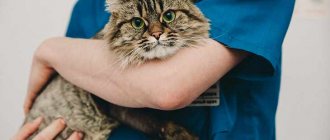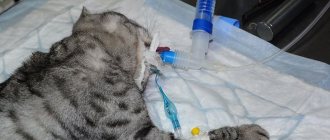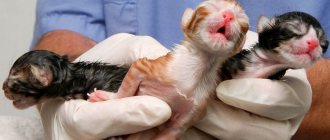Cats are animals with highly developed natural instincts. Therefore, as a rule, intervention in the lambing process is not required. However, every pet is dear to its owner. Therefore, the cat owner must have an understanding of cat pregnancy and childbirth in order to help her or provide assistance in case of complications. If there are no pathologies, then the cat will give birth to offspring on its own. And the owner’s role will be reduced to observation, organizing a place for lambing and good feeding.
What to do if the cat cannot give birth on her own
If a cat has insufficient contractions, they can be induced by stroking the animal's stomach and back with your hand.
If the kitten is stuck in the birth canal, it is necessary to pull it out. You need to pull it out carefully, you cannot pull the head, this can lead to fractures of the cervical vertebrae and the kitten will die. It is safer to pull on the folds of skin on the body or neck, or on the paws, alternately to the left and then to the right. In case of dry birth and leaked amniotic fluid, lubricate your fingers with Vaseline, and then begin to pull the kitten out. Try to pull the kitten along the cat's body, supporting the mother's abdomen with your other hand.
What not to do during childbirth
Sometimes the owner of a mustachioed friend can harm the animal due to inexperience.
To prevent this from happening, take a close look at the list of things that are strictly forbidden to do when giving birth to a cat:
- Do not pull a newborn cat by the head or neck.
- It is also forbidden to pull too hard on just one paw.
- It is prohibited to use antiseptics that are intended for treating human wounds.
- Do not allow a giving birth cat to eat more than two placentas.
- It is prohibited to turn on bright lights in the maternity ward. Moreover, it should not be included in the first 2-3 weeks of a kitten’s life, as this can cause cataracts.
- In the first 2-3 hours, try not to pick up newborns. Leave them in the care of the mother: she will lick and warm the babies on her own.
Physiology of pregnancy and childbirth in cats
- Short-haired and hairless breeds carry their offspring for approximately 55–65 days.
- Long-haired females – up to 75 days.
Pregnancy in cats lasts from 60 to 75 days.
The duration of pregnancy depends on the number of kittens. The more babies a mother has inside, the faster labor can occur. Conversely, one or two babies may be born late.
Conception usually occurs after 25–50 hours, from which point it is customary to begin the countdown.
Phases of pregnancy
On the fiftieth day, the kittens begin to move actively.
- On the twentieth or thirtieth day, the nipples begin to rise and become rounded. They turn pink and begin to peel off. The animal sleeps more, becomes more cautious, moves less, and begins to eat more. The abdomen increases by about one and a half centimeters, becomes rounded, elastic, and the embryo can be felt.
- At the beginning of the fifth week, the volume of the abdomen is approximately two and a half centimeters, the volume of the fetus reaches three and a half centimeters.
- At the beginning of the sixth week, the fruits descend into the peritoneum and stretch out, becoming cylindrical in shape. The belly gets bigger if there are more than two kittens inside. If there are one or two babies inside, the belly remains practically unchanged. It is strictly forbidden to palpate the female’s peritoneum at this time in order to avoid damage to the fruits. After the sixth week, the abdominal area increases laterally and takes on the shape of a pear.
- Starting from the fortieth day, accelerated development of the fetus occurs and fur is formed, which for the mother may mean a decrease in appetite.
- On the fiftieth day, the kittens begin to move actively. The harbingers are considered to be relaxation of the pelvis, and increased mobility of the sacral bone, swelling of the vulva and mucous discharge, and the appearance of colostrum. At this time, the cat is actively looking for a secluded place to build a nest.
Stimulation of labor in cats and preparation for it
Many owners who have got a cat and are faced with its first birth are wondering: how to help a cat give birth for the first time? The question is very relevant and correct, since when giving birth for the first time, an inexperienced cat panics and fusses - after all, this process is new to her and she can only guess at a natural level what exactly she needs to do.
Before giving birth, the cat begins to meow hysterically
The cat's behavior during this period may change beyond recognition. She may begin to rush around the house, meow hysterically and rub against her owner, calling him for help.
But what can the owner do? After all, he cannot know in advance how his pet will react to the kittens and to the process of delivery itself; there is a high probability of psychological trauma and physiological disorders in the body.
How a cat behaves during childbirth, especially the first, largely depends on the individual characteristics of the psyche and the body as a whole. Some individuals literally require the owner to be constantly nearby, need stroking and affection, while others, on the contrary, hiss and scratch the person, clearly making it clear that he should not come close. In such cases, all that remains is to observe and hope that the cat will cope on its own.
If your cat is acting aggressively, call your veterinarian
It happens that all the due dates set by the veterinarian for a cat pass, but the female is not going to give birth. How then can you help a cat give birth at home, because kittens gain weight and exhaust the cat more and more, foreshadowing problems with passage through the birth canal.
In such cases, only a veterinarian, but in no case the pet owner himself, can decide whether it will be necessary to help the cat give birth and how exactly to do this! For example, folk remedies used during childbirth for a “difficult” cat can provoke an even longer process, which will cause a protracted delivery, poor pushing, and bleeding.
The introduction of hormonal drugs such as Oxytocin or any other analogues for an unprepared cat can be the beginning of the end - a rupture of the cervix will occur. That is why the cat is examined in advance by a veterinarian-obstetrician and, based on the tests and data obtained, decides which drug should be used.
How to prepare for childbirth?
Gather and prepare the following materials and supplies:
- A cat definitely needs a place to give birth; she will not give birth on ordinary bedding or on the floor. Choose a large box so that she can sit in it with the kittens. Place soft material without long threads on the bottom of the box so that the kittens can move on it without damaging their paws and claws. If you do not have time to prepare the nest, or the cat does not like it, then your pet will personally begin to find and improve a place for birth. Therefore, you need to convince the cat that your house is more comfortable and reliable. Place the box in a sheltered and warm place and place the diapers in it.
- Fabrics and gauze, rags.
- Pipette and rubber bulb.
- Scissors.
- Threads.
- Antiseptic drugs.
- A box for kittens.
- Phone number of the veterinary hospital.
You need to prepare for an urgent call to the doctor or a visit to the hospital if complications arise during childbirth. Sometimes it will be safer to personally deliver your cat to the hospital. For this purpose, you will need to first prepare a container for transporting the cat.
Video text
INSTAGRAM (watch more videos): afina_cattery
Would you like to say “THANK YOU” to the Afina-TV channel? Material gratitude and support are welcome! Link for quick donations (from anywhere in the world in any currency, any amount): https://www.donationalerts.ru/r/afinatv
Collecting on camera: My dollar WebMoney: WMZ Z351834018916
My hryvnia WebMoney: WMU U256338536053 THANK YOU FOR YOUR SUPPORT.
Website where our kittens are sold: www.afina-tv.com
ADVERTISING on the Afina-TV channel: www.afina-tv.com/vashareklama/My email VK group: https://vk.com/afina_tv_cat FB group: https://www.facebook.com/catteryafina/
INFORMATION FOR CHILDREN: Channel of my daughter Katya, who is 6 years old: https://www.youtube.com/channel/UCFMN.
The cat Fifa CANNOT give birth by herself: 2 ACTIONS, after completing which your cat will give birth WITHOUT CESAREAN
What signs can you use to know that a cat is about to give birth?
A cat, just like a person, has certain signs that indicate impending birth:
- The animal is constantly kept in a box or on a bedding specially designed for childbirth.
- The cat moves around the house only to drink food or water, the rest of the time it lies and sleeps.
- If the owner gives hard and heavy food, she may refuse it completely, as an overfilled stomach leads to discomfort or pain.
- The external genitalia swell and become red.
Pregnant cat
- A small amount of red or yellow mucus may be released.
- Reddening of the nipples, the beginning of colostrum secretion, this indicates the established process of lactation.
- A few hours before the cat lambs, her mucous plug comes out, this indicates the beginning of the birth process.
- At the beginning of active contractions, the cat begins to meow loudly and protractedly.
- Often the animal tries to leave the family place, to hide from people, this should not be allowed so as not to harm the offspring.
Important! To avoid unpleasant consequences, you can first agree with a veterinarian to provide assistance during labor. There are clinics where a doctor can visit your home even at night
Necessary preparation
Despite the fact that giving birth to a cat is a natural process, the owner of the animal will face considerable troubles. A cat living at home needs to create a special environment for the birth of offspring, provide veterinary care if necessary, “meet” new residents and make sure that they and the mustachioed mother have enough nutrition.
Arrangement of the “room” for childbirth
Arrangement of the place
If you do not prepare a place for the cat to give birth in time, she will find it herself. This is not always convenient, since a cat is a secretive animal, and it will hide with special care. Some cats leave home altogether and return, bringing kittens one at a time.
The ideal cat place would be a box or large basket with high walls. This could be a house from a pet store, a cardboard box, or even a cabinet drawer. It is important that it is sufficiently closed and spacious, but at the same time not too large - the expectant mother should feel safe and calmly feed the kittens.
Place the “maternity ward” away from drafts, bright light and doors: the place should be secluded and darkened. Place an old small mattress at the bottom of the box or drawer, then lay down an oilcloth, and place a regular baby diaper on top.
A quiet, cozy place where the cat will not be disturbed
Important! It is worth showing the cat the place in advance. If she still stubbornly seeks shelter, ignoring the prepared place, you should take her to the box when the birth process has already begun.
What materials, tools and medications may be needed
You need to thoroughly prepare for childbirth. To do this, you will need not only to arrange the place where the kittens will appear, but also to prepare some tools and materials that may be needed in case of complications that arise. In addition, you should make sure you have medications on hand.
For home birth you will need the following:
- telephone number of a veterinarian who can be contacted at any time;
- clean strips of fabric - you can tear a cotton sheet;
- disposable diapers; sterile threads (pre-soaked in alcohol); sterile scissors with blunt ends (can be boiled for 10-20 minutes);
- gloves;
- alcohol antiseptic or alcohol for hand treatment;
- container for placenta;
- warmer;
- baby bulb or pipette for suctioning mucus.
- healing ointments, for example, Levomikol, Vaseline, oxytocin, potassium gluconate.
You should prepare as much as possible for childbirth, so as not to be terrified of searching around the house for everything you need.
Prepare everything you need in advance for cat and kitten hygiene
How can the owner help the pet and is it necessary to do it?
If the cat's condition is normal, she copes with her maternal responsibilities (licks the babies, bites the umbilical cords), the owner's intervention is not required. At the same time, you must constantly be nearby to help your pet at the right time. In some cases, a veterinarian may be required to properly deliver the baby.
If labor does not begin for a long time or contractions drag on
If the cat's water broke more than half an hour ago, and there are no contractions, you can inject the woman in labor with oxytocin. It is advisable to first consult with a veterinarian by phone regarding dosage. An alternative way to stimulate labor is to insert a pipette lubricated with Levomekol ointment into the cat’s vagina in a circular motion. Light touches to the abdomen also stimulate contractions.
If the kitten can't get out
If a kitten is stuck in the birth canal, you need to help it be born. How to deliver a cat? To do this, you need to wait for the contraction and place your index finger, lubricated with Vaseline, into the cat’s vagina a few centimeters. Next you need to move the skin down, grab the kitten and, making movements in different directions, gently pull it towards you. If the baby walks butt or paw forward, you need to call a veterinarian. You will probably have to have a caesarean section.
If a newborn kitten shows no signs of life
If the baby is born, but does not squeak or move, you need to take action to resuscitate it. To do this, you should clear his airways, tilt his muzzle down, and hold him by the hind legs. If this does not help, you need to shake the baby, holding him upside down. You can rub the newborn's back and chest with a soft cloth for 3 minutes.
If the next kitten does not appear for a long time
When a cat gives birth, the interval between the appearance of kittens is on average from 5 minutes to 1 hour. Sometimes the interval reaches 4–6 hours. If the next kitten does not appear during this time, how can I help the cat give birth? You need to call a veterinarian. When a cat cannot give birth, injections of special drugs or surgery are required. The doctor will examine the pet, assess its condition and the condition of the kittens. There is a risk that the baby suffocated in the womb, and in this case, the mother in labor needs urgent medical attention.
The birth process
It is impossible to predict how long labor will last. Even for a cat that gives birth frequently, this process can take varying amounts of time. The average duration of labor is from two to six hours , but there may be a longer period - up to a day.
Lambing is divided into three stages:
- The first stage is contractions;
- The second stage is the birth of kittens;
- The third stage is the release of the placenta.
Lambing begins with uterine contractions, which is accompanied by colorless vaginal discharge. At the end of the first stage, contractions become more pronounced and frequent. The cat is breathing heavily and may make sounds.
The second stage begins with the discharge of amniotic fluid. After this there must be a birth. The period after the water breaks and the kittens appear should not exceed two hours. Otherwise, the help of a veterinarian is required.
After the kitten comes out, the cat must lick it. If she does not do this, then the owner needs to clear the mucus from the nose and mouth.
Kittens may appear one after another, but sometimes there is a gap of up to two hours. You can tell if labor has ended or not by carefully palpating the animal’s abdomen. They are easily felt if they are still there. This examination stimulates labor, but it should be carried out with extreme caution.
The third stage is the release of the placenta after the birth of each kitten. The cat chews the umbilical cord and usually eats the placenta. The cat owner must ensure that the number of kittens and the number of afterbirths coincide. If the placenta remains in the birth canal, it can cause complications after childbirth.
We deliver a cat at home
https://youtube.com/watch?v=XRJGfWQOKtk
It happens that all the due dates have passed, but the cat does not even think about giving birth. In such cases, you should definitely contact your veterinarian.
Induction of labor
Oxytocin and its derivatives can provoke cervical rupture in a mother who is not ready for the process. Traditional methods will complicate and prolong childbirth and provoke weak attempts.
Primiparous females often behave more nervously and aggressively than their “experienced” friends. This behavior is determined solely by the first experience. All that is required from the owner is to reduce the pet’s stress as much as possible by calming, stroking, and speaking kind words. Sometimes it is necessary to resort to medicinal sedation, giving sedatives to relieve tension.
If your cat needs help during the birthing process, she will let you know.
Most often, mothers themselves know what needs to be done, but sometimes a little assistance is needed. When the pushing begins, you can place your palm under the hind legs so that mommy can rest. During pushing, spontaneous bowel movements may occur - you should keep cleaning supplies nearby.
An attempt to turn the kitten face forward during birth.
The appearance of the amniotic sac requires special attention. If the baby walks butt forward, you can try to turn him around
Lubricate your little finger with Vaseline and carefully insert the shell back. Place the woman in labor on her hind legs, while supporting her front legs, and gently shake off her body.
The kitten should turn around on its own in this way.
It is permissible to stroke all the time, lightly resting on the chest area. This will help with pushing. In the case when the water has already broken, the fetus is within visible limits, and the contractions have suddenly stopped, oxytocin can be used to stimulate contractions. To do this, a tenth of the drug ampoule is administered intramuscularly. The needle, after treatment, must dry out due to the destruction of oxytocin when interacting with alcohol.
You can't pull a kitten out of your crotch
You can help widen the passage with a Vaseline-lubricated finger, carefully and very slowly pushing the boundaries. If the measures taken do not produce results, call a veterinarian immediately
Normal course of labor
https://youtube.com/watch?v=XDLZ6_6ahkA
During the normal course of labor, you can help by pulling the afterbirth a little towards you and letting the woman in labor eat it. If the mother does not lick the baby, free him from the film, wipe him with a dry cloth, and give him to the mother.
In between contractions, the mother can feed the kittens, you can give her some water, but under no circumstances feed her. When the next contractions and attempts begin, the babies should be removed from her.
How many kittens, so many placentas?
It is necessary to compare the number of kittens and placentas. In nature, a cat eats the placenta, which contains nutrients.
The afterbirth remaining inside will create a pathogenic environment, which will lead to serious inflammation and subsequent bad consequences. The appearance of the fetus with its paws forward is also a pathology
You need to carefully push it back in. With repeated contractions, the fetus may be delivered correctly
The cat ruptures the amniotic sac during childbirth on its own.
The cat itself must rupture the amniotic sac, otherwise you need to tear the film yourself from the side of the baby’s face. The newborn should squeak. If this does not happen, you can try to revive him. To do this, turn it over with its paws down, holding its head, shake it a little, pressing on the chest to allow fluid to drain out of the lungs
You need to act carefully so as not to damage the fragile cartilage
If the cat no longer has babies, its belly becomes soft and elastic within half an hour. This can be determined by palpating the abdomen. However, this data does not apply to the case if oxytocin was used for stimulation. The abdomen may be tense for a longer period.
Help with normal childbirth
Childbirth is a very intimate process, so the owner must provide his pet with a calm environment. If childbirth proceeds normally, then any active intervention is not recommended; nature itself will do its job.
In case of slow labor, after the fetus has already appeared in the birth canal, you can slightly speed up its progress:
wait for contractions and pushing (their onset can be understood by the characteristic contractions of the abdomen); slowly and carefully pull out the kitten, carefully grasping it with your fingers through a napkin; alternately, just a little, rotate the kitten left and right.
Abnormal presentation of fetuses
In addition, all types of abnormal presentation of fetuses can lead to dystonia. Note that a kitten with its tail towards the birth canal is not considered a pathology (this is a breech presentation), but situations when the fetus turns out to be turned across the uterus do not end well. Even when a cat turns out to be hardy enough to push such a kitten out of the reproductive tract, her body’s reserves are still very quickly depleted, and therefore the pet ends up completely exhausted.
But! Today, veterinary obstetricians tend to assume that malpresentation of fetuses in cats leads to dystonia relatively rarely.
This happens much more often when the animal has some kind of pathology of the cervix, causing insufficient dilatation of the organ. Everything is not good at all when your pet has large fruit. In such cases (when the animal manages to give birth to its first “hero”), we strongly recommend that you immediately call a veterinarian.
Keep in mind that the excessively large size of kittens guarantees primiparous cats problems not only during birth: the animal will also need help later (rupture of the genital tract, endometritis, etc.).
If your pet has experienced a difficult, protracted birth, be sure to give the animal complete rest after it. What to do if it doesn't want to eat? Don't worry: your cat's appetite will gradually return once the cat is completely rested.
How do you understand that something has gone wrong and the animal needs help?
Most often, cat birth goes well, and the animal gives birth on its own. It happens, however, that a pet needs help both during lambing and after the birth of kittens. This is due both to the physical condition of the pet and to its attitude towards its own offspring.
If a cat gives birth for the first time, she needs constant attention from her owner.
Discharge after childbirth
If your cat bleeds profusely within 10 minutes after lambing, you should call a veterinarian. This condition is often caused by a rupture of the uterus or vulva. Moderate bleeding within 2 days after lambing is considered normal, provided there is no unpleasant odor, mucus or pus. If the discharge does not disappear for a long time, you need to contact a veterinarian.
A cat who gave birth has a big belly
A large belly in a new mother may indicate an accumulation of gas and feces caused by constipation, or a helminthic infestation. Another reason for an enlarged abdomen may be uncompleted childbirth. To find out whether the fetus remains in the uterus, you need to palpate the cat's belly. With an incomplete birth, the muscles remain tense, and the kitten can be easily palpated. If the baby is moving, you can wait up to 24 hours. If there is no labor, you need to urgently take the cat to the veterinarian.
Lack of milk in a cat
The absence or insufficient amount of milk in a cat who has given birth may be associated with stress or aggressiveness of the new mother. The owner is required to create a calm atmosphere for his pet, in which she can express her maternal instinct and feel safe.
The cat does not approach the kittens
Why doesn't a cat approach kittens after giving birth? There may be several reasons. In cats, the maternal instinct “wakes up” later than the sexual instinct, so young mothers can ignore their offspring. For this reason, you should not allow the animal to mate until it reaches 2–3 years of age. What other reasons could there be for a mother to ignore her offspring? A few examples:
- lack of milk;
- developing mastitis, in which sucking kittens causes pain to the mother;
- eclampsia (acute calcium deficiency);
- stress (can be caused by the appearance of another pet in the house or the location of a box with kittens in a passable place);
- non-viable offspring.
Often cats do not want to approach their offspring if the kittens are often touched by strangers. Babies lose their original smell, which provokes the extinction of the cat’s maternal instinct. You should not touch the kittens unless necessary; it is better to leave the family alone.
Sometimes the mother does not accept all the babies, rejecting one of them. This is due to the fact that the cat senses its non-viability. In this case, it happens that the mother mistakes the kitten for a weak one with a low body temperature. In this case, it makes sense to pick up the newborn, wrap him in a soft towel and keep him warm. After this, return the baby to the mother. Perhaps the situation will change and the cat will accept the kitten back.
If no method has proven effective, and the cat still does not approach the babies, the owner will have to take on maternal responsibilities. You need to stock up on kitten formula, pipettes, and bottles. Babies should be placed in a warm, dry place and given a heating pad to replace the warmth of the mother's body.
Signs that indicate the onset of labor
1–3 days before the onset of labor, you can understand from the cat’s behavior that this moment will soon come:
- The future tailed mother is actively looking for secluded places, every now and then trying to hide in the closet or behind the sofa. Digs there, trying to build a nest. The pet becomes very affectionate, constantly demands attention, and can sometimes be annoying. It rarely happens that a cat, on the contrary, becomes overly aggressive and hides from its owners. Other symptoms:
- at this time, the loop increases greatly, and clear or light pink discharge is observed;
- the cat begins to lick itself more often;
- There is a loss of appetite up to complete refusal of food.
- When there are a day or a little less left before lambing, the animal’s body temperature drops to 37°C.
- 4–8 hours before lambing, the animal begins to hunch over. This is how the body reacts to training contractions of the uterus. This process causes great anxiety in the pet; she may complain to the owner, seeking his support. But another option is also possible - she will try to hide.
- 4 hours before labor, the mucus plug comes off. It is a small transparent clot, sometimes it can have a yellowish or greenish tint and include small inclusions of brown, which is considered normal. Often the plug comes out during urination or in parts. But this moment may not be noticed in an overly clean animal.
- When the temperature rises to normal—38–39°C—this means that there are about 2 hours left before birth.
Call a veterinarian immediately if:
- a furry pet carries kittens longer than expected;
- the pet experiences fever, vomiting and convulsions;
- bleeding lasts more than 10 minutes and is accompanied by an unpleasant odor.
Premature birth
Sexual infections, physical trauma, and severe stress are some of the main causes of premature lambing. This problem can occur in older cats or in representatives of breeding and selective breeds who are giving birth for the first time.
Be sure to show your pregnant cat to a veterinarian, and before giving birth, agree with him about help if necessary.
If lambing occurs when the gestation period is 51 days or more, the kittens are considered viable and must be fought for their lives. Call your veterinarian immediately. But under no circumstances try to stop contractions in order to postpone labor until a specialist arrives. You will have to deliver the baby yourself.
How to behave with a pet
If this is your first time attending the birth of a family pet, then excitement is a natural process. You must understand that when a furry mother goes into labor, she experiences pain, fear and needs support. Your behavior will largely determine the successful outcome of the case. Even if you don’t really understand how to act, control yourself. Get together and provide all possible assistance:
- Try to ensure that no strangers or curious people gather near the lambing area.
- Apart from the owner, there should be no other people in the cat's field of vision, even if they are family members to whom the cat is accustomed.
- Talk kindly to your pet, show her that you are nearby and will not abandon her in difficult times. Stroke it from top to bottom. Speak kind words.
Your participation will calm the cat before giving birth
Cat after birth
What to do after giving birth to a cat?
This is also a popular question among owners. The birth can be considered complete if, 1.5 - 2 hours after the birth of the last kitten, the cat has no contractions, the stomach is soft and all the placenta have come out. During this period, the main thing is to feed the cat properly and protect it from stress.
When can a cat become pregnant after giving birth?
Owners often ask how quickly a cat can become pregnant after giving birth and can a cat become pregnant immediately after giving birth? It must be taken into account that giving birth and feeding kittens is a huge burden on the cat’s body, which exhausts the animal and can lead to diseases.
The maximum number of births a cat can give birth to is once a year. In this case, the cat has the opportunity to recover from previous births and raising kittens.
When can a cat be spayed after giving birth?
Sometimes owners are interested in whether it is possible to sterilize a cat after giving birth and when can a cat be sterilized after giving birth? Veterinarians cannot answer this question unequivocally. The answer to the question of how long to sterilize a cat after giving birth depends on whether the cat is nursing kittens. If your cat is nursing kittens, you should not spay her immediately after giving birth. As a rule, veterinarians say that a cat can be sterilized no earlier than 2 months after birth. Sterilizing a cat after birth is fraught with serious complications (including death) and is possible only in exceptional cases.
The cat does not have milk after giving birth
There are several reasons why a cat does not produce milk after giving birth:
- Stress.
- Infection. In this case, treatment with antibiotics is necessary.
- Lack of maternal instinct - occurs, as a rule, in a young cat.
- Poor nutrition. Give your cat more dairy products, vitamins and protein.
- Hormonal imbalance.
In any case, you need to contact a specialist and follow his recommendations.
What to feed a cat after giving birth
Many owners are concerned about the question of what to feed their cat after giving birth. How to feed a cat that has given birth?
During the first 10 to 12 days after birth, the diet of a nursing cat should include only nutritious, natural and easily digestible foods: fermented milk, cereals and vegetables. If your cat really lacks meat, you can give boiled dietary meat.
It is better to exclude dry food: a large amount of salt and a small amount of liquid makes it difficult for a cat to produce milk after birth. However, if a cat has allergies, a sudden change in diet is contraindicated. In other cases, familiar foods are introduced into the diet of a nursing cat on the 14th day. Please note that after giving birth, your cat needs to be given foods that contain magnesium and calcium. Ask your veterinarian which supplements to choose.
It is important that food for a nursing cat is always fresh. Water must be freely available
Don't listen to advisers!
Cat lovers forums are filled with advice on what to do if your cat is unable to give birth. If we summarize all the advice, it turns out that the only way to help a young mother is to start injecting Oxytocin.
Oxytocin has been regarded for many years as a dangerous drug, the use of which is only relevant in extreme cases. Do not use medications that have not been prescribed by your veterinarian. During prolonged labor, a veterinarian must be called to your home and all recommendations given to him must be followed.
During prolonged labor, in extreme cases, the veterinarian may push the kitten or use special forceps to move it along the birth canal. Do not carry out such manipulations yourself, as too much pressure can lead to rupture of the walls of the uterus or birth canal. In this case, intrauterine bleeding will open, the kittens will most likely die, and only a few minutes will be left to save the cat.
What help a cat may need during childbirth
Sometimes a cat cannot give birth on its own, and in such cases it needs human help. But you should not always call the veterinarian immediately; in most cases, you can do without the help of a specialist
It is important to understand that in the case of normal labor activity of the animal, you should not interfere, since a “nervous mother” may eat one of her children
Did you know? A cat's hearing system is so developed that it can detect ultrasonic waves. A mustachioed companion can eavesdrop on the “negotiations” of rodents, even if they do not move. The fact is that mice and rats communicate with each other in the ultrasonic range.
So, let's figure out how and in what cases you need to help a cat during childbirth:
- If the contractions are not strong enough for the cubs to come out, then it is necessary to help the animal. To do this, you should massage the cat’s back and belly, do it actively, but not with all your might.
- If the baby is stuck in the mother's birth canal, you need to help get it out. This must be done very carefully and under no circumstances should you grab the baby by the head, as you can break the cervical vertebrae and kill the kitten. You need to pull it out by the paws (alternately pulling the right and left ones). Another option is to pull out the folds that form in the neck area of newborns.
- It also happens that all the amniotic fluid leaks out of a cat, and the babies are born with great difficulty. In this case, you need to lubricate your fingers with Vaseline oil and help the cubs. You should not pull too hard and not in a perpendicular direction to the mother, as this can cause serious injury to her birth canal.
- Sometimes during childbirth the paws appear first, instead of the head. In such cases, you need to put your paws back into the cat, and after a minute the baby will change position and come out normally.
- With each kitten, the placenta must also be delivered. If this does not happen, then the owner needs to remove the placenta himself, otherwise the cat may experience an acute inflammatory reaction. When a baby is born in the placenta, and the cat does not immediately chew it, the owner must tear it apart himself, because otherwise the baby may suffocate.
- At the moment of placenta rupture, the little kitten always tries to take the first breath, but he is still all wet, and there is a lot of liquid in his nasal passages, which, when inhaling, can easily penetrate into the lungs. To prevent this from happening, immediately after the placenta ruptures, take the baby in your arms and lower it head down, when you hear a small squeak, which means the kitten can already breathe on its own.
- Immediately after birth, examine the newborn's mouth, especially the tongue. If it is pink, everything is fine, if it is blue or purple, the baby has hypoxia (lack of oxygen). In case of hypoxia, the kitten needs to massage the chest area until it begins to breathe normally. As a last resort, call a veterinarian.
Important! If during childbirth the cat’s temperature rises above 39.5 °C or drops below 37 °C, then it is necessary to urgently call a veterinarian.
- Sometimes a cat is unable to gnaw the umbilical cord, or simply forgets to do so. In such cases, your help is needed; for this you will need: thick silk thread, sharp scissors, antiseptic. We tie the umbilical cord with a thread at a distance of about 2 cm from the baby’s tummy, then cut it with scissors and treat it with an antiseptic.
- Once labor begins, several warm heating pads should be placed on the newborn bed.
Complications during childbirth
Of course, births in cats do not always go well. Sometimes unexpected complications happen.
If the kitten gets stuck during birth, do not allow the cat to bite through the bubble. In this position, the baby may suffocate. You can help the kitten: during the next contraction, gently pull him by the body. To improve patency, pre-lubricate the emerging part of the newborn’s body with Vaseline.
If a cat cannot give birth, she needs help
You may even have to urgently call a veterinarian for help. Such measures should be taken in the event of:
- long-lasting contractions, without the birth of babies;
- if the cat does not give birth for a long time, she experiences severe weakness, rapid heartbeat, body temperature above 39 degrees, loss of consciousness - urgently call a doctor at home;
- Bloody or purulent discharge with an unpleasant odor appears from the cat’s genitals.
The need to induce labor
Stimulation of labor is used in cases of late lambing or a prolonged interval between the birth of babies (more than an hour), when the pet cannot give birth on its own.
You need to wait some time. When 1-2 kittens are born, labor may subside and then reactivate (in some cases it can take up to a day). Labor can be stimulated by massaging the mammary glands and nipples. In extreme cases, it is possible to use oxytocin, a drug that promotes contractions of the uterine wall. It should be borne in mind that improper use of the product can cause the death of the mother and offspring.
What to do if the fruit is large?
How to help a cat give birth to a large kitten? Even if he moves head first, his shoulder area can prevent birth.
We fix the problem this way:
- After lubricating the vagina, insert your finger inside and try to feel the elbow bends of both paws of the kitten one by one.
- Grab each paw at the shoulder joint.
- Turn the baby from side to side, try to alternately stretch its paws forward.
- If the baby is in the lower part of the birth canal, force the pet to push. To do this, you need to stretch the vagina.
If the fruit is large, the cat needs help
What to do if a cat cannot give birth?
If the animal is unable to give birth on its own even under the influence of Oxytocin, it is necessary to immediately contact a veterinarian. The doctor may resort to a last resort option - a caesarean section. Many owners are afraid of surgery, but it is considered the safest method of treating fetuses without risking the life of the animal. The procedure is carried out in several stages:
- they use general anesthesia, during which the cat falls asleep and cannot move;
- the peritoneum and uterus are incised;
- the fruits are removed along with the amniotic sacs and placenta;
- suturing the uterus and abdominal wall;
- use an antiseptic to eliminate the risk of infection;
- waiting for the hypnotic effect to end.
At what age can a cat give birth?
Those owners who have not previously encountered cats should remember that sterilization should not be shelved, since these animals can begin to bear offspring very early. The average cat goes through puberty by the age of eight months. If a cat owner plans to have kittens, then it is better to bring the animal with a partner after a year. The best option would be the fourth heat.
A cat's pregnancy lasts about two and a half months.
It is very easy for a person who has a cat at home to understand when she begins to go into estrus, that is, into heat. Based on the behavior of the animal, it immediately becomes clear that the cat has matured.
The entire period of estrus in cats can be divided into three stages. The first lasts about three days. At this time, the animal will constantly rub against its legs and require a lot of attention. Then there will be several days of rolling on the floor meowing loudly. At this time, the cat often walks with its tail moved to the side. Then comes the third stage, when the discharge is still there, that is, the cat attracts males, but at the same time it becomes aggressive towards them. If fertilization does not occur, this period can last up to 20 days. In a fertilized cat, it is reduced to one week.
A cat's pregnancy lasts about two and a half months. At one time, an animal can give birth to an average of four to seven kittens, but a lot depends on the breed of the cat. A person should carefully monitor when a pet goes into labor. If they are premature, which is not uncommon for the first time, then the babies are unlikely to survive. It’s also bad when a cat can’t give birth for a long time.
For the expectant mother you need to prepare a bed
When should you contact a veterinarian?
As for placentas, they should all come out within 12 hours after the end of labor. If there are fewer placentas delivered than kittens were born, then it is urgent to show the cat to a specialist.
Below is a list of situations when you and your cat will also need the help of a veterinarian:
- Premature birth. The average pregnancy rate is 51-71 days. If labor starts earlier, you should see a doctor!
- Sometimes it becomes necessary to artificially induce labor. But in each specific case, only the doctor decides HOW to do this;
- Attempts last half an hour or more, but labor never occurs;
- Vivid bleeding indicates tissue rupture. Only a doctor can solve the problem;
- If the day after giving birth the cat experiences vaginal discharge with a particularly unpleasant odor;
- If a lactating cat then develops a fever;
- If the mammary glands are inflamed and hardened;
- If the kittens are cold and hard to the touch.
Video











